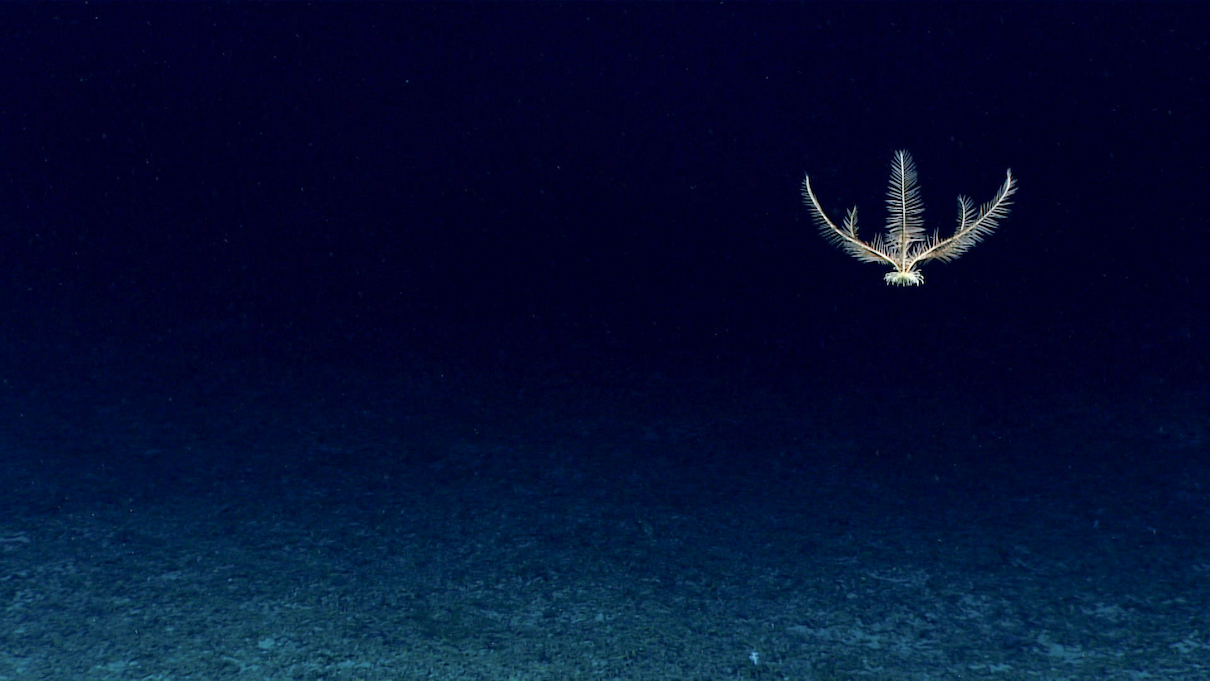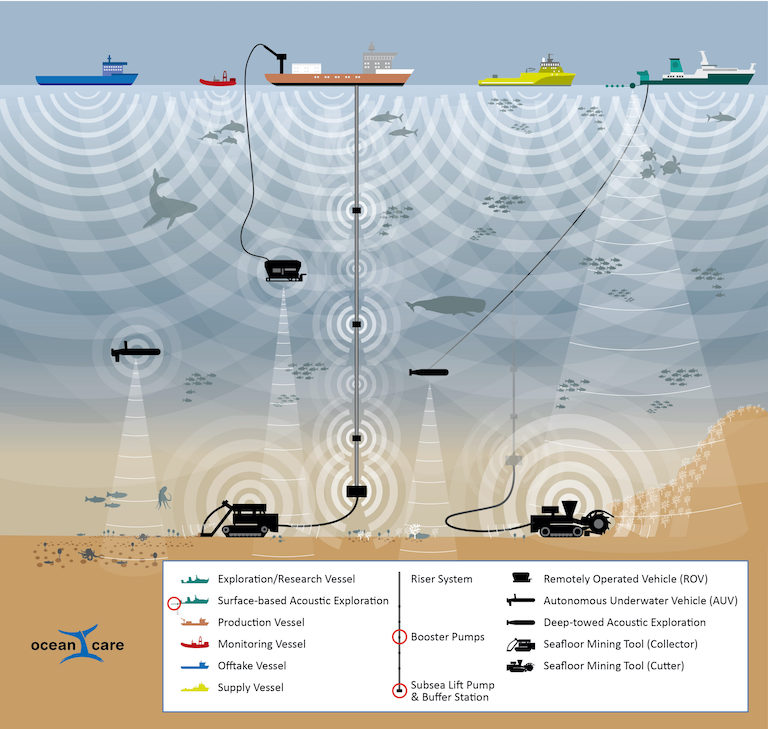If marine noise pollution is bad, deep-sea mining could add to the cacophony
Nov 24, 2021
- A new report suggests that the noise pollution produced by deep-sea mining activities could have far-reaching effects on the marine environment, from surface to seafloor.
- While there are many studies that measure the impacts of noise pollution on marine life, more research is needed to fully understand how sound from deep-sea mining could affect the ocean.
- Due to the paucity of information, experts say a precautionary approach to deep-sea mining noise is required and that clear regulations must be put into place by the International Seabed Authority.
- While deep-sea mining has yet to begin, a subsidiary of Canada-based The Metals Company plans to start mining in less than two years.
It’s not easy to try to describe how a dolphin experiences sound in the ocean, says Lindy Weilgart, a noise pollution expert at Dalhousie University in Canada.
“We have terrestrial ears and we’re in air, right?” Weilgart told Mongabay in a video call. “So you think, ‘Oh, so the ear’s a bit different,’ but it’s also how they receive sounds. We receive it directly into our inner ear, whereas for dolphins, it’s conducted through their lower jaw. And because [their bodies] are mostly water, the sound couples very efficiently into their bodies.”
While reluctant to make a comparison, Weilgart said that dolphins and whales might experience underwater sound similarly to how we hear low pitches on a cranked-up stereo.
“You would feel it in your lungs,” she said. “I suspect that’s more the case with whales and dolphins — it actually is a whole-body feeling as they’re immersed in the sound.”
Whale and dolphin species have been known to stop feeding and vocalizing around certain types of human-made noise, such as sonar equipment, or to become disoriented and strand on shore, which is what happened to a pod of melon-headed whales (Peponocephala electra) in 2008 in Madagascar. Noise has also been shown to cause air damage to fish called pink snappers (Chrysophrys auratus) and reduce the larval quality of Atlantic cod (Gadus morhua). Airguns have caused widespread death in krill and other kinds of zooplankton, and studies have even shown that human-made noise impairs aquatic plants like seagrass.

While evidence is mounting that anthropogenic noise adversely affects ocean life, regulatory measures aimed at curtailing noise pollution are generally lacking. This is certainly true in the context of deep-sea mining, a controversial activity that, if allowed to proceed, would entail corporations extracting metals like copper, cobalt, nickel and manganese from the seabed — and creating a lot of noise in the process.
Cyrill Martin, an ocean policy expert at the Swiss NGO OceanCare, said that noise pollution is currently a “wallflower issue” in the larger matter of deep-sea mining, and that more research urgently needs to be done to fill in knowledge gaps. Until more is known, he said, deep-sea mining needs to be approached with a “precautionary principle.”
“The main data we have from deep-sea mining activities stems from laboratory conditions,” Martin told Mongabay in a video interview. “So there’s a lot of data missing. Nevertheless, we do have some data that we can extrapolate from related industries.”
In a new report, “Deep-Sea Mining: A noisy affair,” released on Nov. 22 by OceanCare, Martin and colleagues draw on past studies, expert interviews and stakeholder surveys to provide an overview of the different types of noise pollution that deep-sea mining would produce — and the potential impacts of this noise. Toward the surface, noise would come from boat propellers and onboard machinery, as well as sonar and seismic airguns used to help explore the seafloor for minerals. The midwater column would be filled with the sounds of riser systems moving sediment from the seafloor to the surface, as well as the motors of robots used to monitor these activities. On the seabed itself, acoustic monitoring tools would generate additional sound. Some kinds of seabed mining would also involve drilling, dredging and scraping along the seafloor. Many of these sounds would create noise as well as vibrations that could affect marine life, according to the report.
The report suggests that deep-sea mining activities could impact species present from the surface to the seabed, with deep-sea species being particularly vulnerable since they use natural sound to perform functions like detect food, and are not accustomed to anthropogenic noise at a close range. Many deep-sea species are also sessile, which means they wouldn’t be able to evade the noise created by deep-sea mining activities, the report says. Even migratory species like whales, dolphins and turtles could be impacted, even while briefly passing through a mining area to feed or breed, according to the report.

“It is important to note that noise from DSM [deep-sea mining] activities will affect life from the sea surface throughout the water column down to the seafloor, given the many sources of noise as well as the ability of sound to travel horizontally and vertically through the ocean,” the researchers write in the report.
Noise can travel remarkably far in the ocean, much farther than it would on land. A 2017 study found that hydrophones lowered 11 kilometers (6.8 miles) into the Mariana Trench — the deepest oceanic trench in the world — picked up the noise of passing ships, as well as natural sounds like crashing waves, whistling wind and whale songs.
Besides noise pollution, studies suggest that deep-sea mining will destroy habitats and marine life with sediment plumes, chemical pollution and light pollution, not only impacting the immediate vicinity, but potentially harming migratory species and key fisheries. Moreover, when marine life is faced with several stressors at once, this might magnify and heighten the impacts of each individual stressor, the OceanCare report suggests.
But proponents of deep-sea mining argue that the benefits of mining outweigh the potential harms. As many nations work to lower their carbon emissions, car manufacturers are producing an increasing number of electric vehicles. According to a report released this year by the International Energy Agency, there will be at least 145 million electric cars, vans, heavy trucks and buses on the world’s roads by 2030. Electric cars require various minerals for their batteries, including lithium, manganese, nickel and cobalt, not all of which are easily accessible via terrestrial sources. Deep-sea mining proponents say that extracting these minerals from the seabed provides an alternative way to feed the fast-growing electric car industry, and that mining the seabed is actually less destructive to the environment than mining the land. Yet conservationists say that deep-sea mining could have far-reaching consequences for a marine environment that we still know very little about, and that the focus should shift to improving terrestrial mining practices and expanding battery recycling.
The International Seabed Authority (ISA), the body responsible for regulating deep-sea mining activities, currently has some recommendations on how mining companies can measure the noise produced by their mining activities to help assess their environmental impact. Yet the authors of the OceanCare report say these recommendations are not “fit for purpose” since they do not require companies to disclose frequencies emitted, and also do not require companies to complete surveys about the marine mammals and other species that may be present and susceptible to the noise.

“There’s not enough guidance for the people working in deep-sea mining to really know what they should be doing,” Martin said. “And the other thing is that [these are] non-binding guidelines.”
The ISA did not respond to Mongabay’s request for comment.
Deep-sea mining has yet to start, but the ISA has already issued 30 licenses for mineral exploration. Giant stretches of the ocean, mainly along the Clarion Clipperton Zone (CCZ) in the Pacific Ocean, have been carved into concessions awarded to various companies and their subsidiaries. In July, the small Pacific nation of Nauru triggered a “two-year rule” that would require the ISA to grant mining permission by July 2024 with whatever regulations are currently in place. The ISA had yet to release a final version of its exploitation regulations, although there is currently a draft. Nauru’s sponsored company, Nauru Ocean Resources Inc. (NORI), which is a subsidiary of Canada-based The Metals Company, plans to mine the CCZ for polymetallic nodules — potato-sized, mineral-rich rock concretions. NORI already has a 15-year exploration license for a 74,830-square-kilometer (28,900-square-mile) section of the region.
On its website, The Metals Company acknowledges that nodule collection will create noise pollution, but says the operation is “not expected to make dangerously loud noises, such as those produced by blasting during land mining.” It adds that most noise will be “localized” and similar to that of typical ship operations, and that it is “unlikely to exceed the gross impact of military and commercial operations, which are far more widespread across the oceans.”
When Mongabay reached out to The Metals Company for comment, a spokesperson echoed additional sentiments on its website, saying that “the acoustic effects of nodule collection are currently being investigated as part of our environmental and social impact assessment (ESIA), and this research will also be used to inform engineering and design decisions to reduce noise wherever possible.”
Martin said he thinks the company is downplaying the potential impacts of noise pollution on the marine environment.
“I think it’s not as harmless as they describe it,” Martin said. “In the deep, dark sea, sound is such a crucial element for so many vital functions for underwater animals that impact would be … considerable and serious.”
Citations:
Dziak, R., Haxel, J., Matsumoto, H., Lau, T., Heimlich, S., & Stalin, S. (2017). Ambient sound at Challenger Deep, Mariana Trench. Oceanography, 30(2). doi:10.5670/oceanog.2017.240
Martin, C., Weilgart, L., Amon, D. J., & Müller, J. (2021). Deep-Sea Mining: A noisy affair. Retrieved from OceanCare website: https://www.oceancare.org/wp-content/uploads/2021/11/DeepSeaMining_a-noisy-affair_report_OceanCare_2021.pdf
McCauley, R. D., Fewtrell, J., & Popper, A. N. (2003). High intensity anthropogenic sound damages fish ears. The Journal of the Acoustical Society of America, 113(1), 638-642. doi:10.1121/1.1527962
Nedelec, S. L., Simpson, S. D., Morley, E. L., Nedelec, B., & Radford, A. N. (2015). Impacts of regular and random noise on the behaviour, growth and development of larval Atlantic cod (Gadus morhua). Proceedings of the Royal Society B: Biological Sciences, 282(1817), 20151943. doi:10.1098/rspb.2015.1943
Solé, M., Lenoir, M., Durfort, M., Fortuño, J., Van der Schaar, M., De Vreese, S., & André, M. (2021). Seagrass Posidonia is impaired by human-generated noise. Communications Biology, 4(1). doi:10.1038/s42003-021-02165-3
Southall, B. L., Rowles, T., Gulland, F., Baird, R. W., & Jepson, P. D. (2013). Final report of the Independent Scientific Review Panel investigating potential contributing factors to a 2008 mass stranding of melon-headed whales (Peponocephala electra) in Antsohihy, Madagascar. Retrieved from https://www.cascadiaresearch.org/oldsite/Hawaii/Madagascar_ISRP_Final_report.pdf
Banner image caption: A curious humpback whale inspecting a diver. Image courtesy of NOAA / Flickr (CC BY 2.0).
Elizabeth Claire Alberts is a staff writer for Mongabay. Follow her on Twitter @ECAlberts.
FEEDBACK: Use this form to send a message to the author of this post. If you want to post a public comment, you can do that at the bottom of the page.